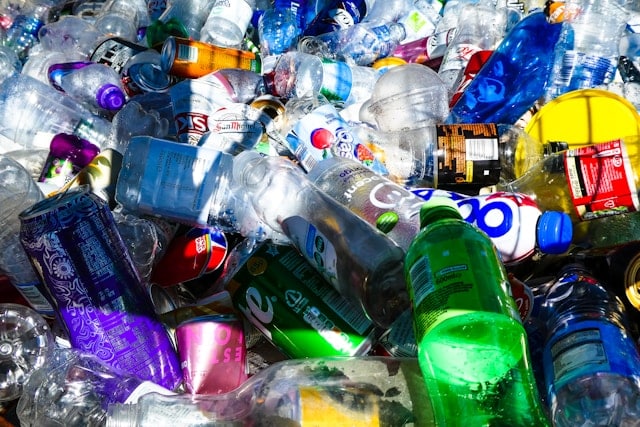A new study published in Nature Medicine revealed a dramatic surge in micro and nanoplastics in the brain, fueling growing questions about their effects on cognitive health.
In 1907, a Belgian chemist named Leo Baekelend developed a revolutionary new material that would soon become a hallmark of the modern era: fully synthetic plastic. It’s not likely, however, that even Baekelend could have predicted the coming ubiquity of his product — nor the scope of its potential health effects. As plastic breaks down, it creates minuscule fragments, ranging in size from 500 µm to as small as 1 nm in diameter. Known as microplastics and nanoplastics, the resulting debris bioaccumulate in animals, plants, and humans, and has been linked to health effects, including increased risk of heart attack and stroke.
These microscopic bits of plastic have been found in human blood, lungs, guts, placentas, and even breast milk and semen. Recently, however, new research published in the journal Nature Medicine seemed to expand the scope. Microplastics and nanoplastics were uncovered in post-mortem brains, livers, and kidneys, with rates “substantially” rising between 2016 and 2024, the study found. In the brains of people with dementia, plastic levels were found to be six times higher than in comparatively healthy individuals.
“Over the past 20 years, [levels of] plastics have grown exponentially in our environment,” University of New Mexico Health Sciences researcher Macrus Garcia, who co-led the study, told Being Patient. Concurrently, his team found, “there’s more plastic in our brains.”
That is reason for concern, Garcia explained, especially if the fragments are small enough to cross the blood-brain barrier; a layer of cells that filters out harmful substances and pathogens.
However, Garcia and other experts say it’s too early to tell whether plastics can be directly attributed to disease. The limited nature of the study – just 28 autopsies – and the lack of control samples makes it difficult to directly link microplastics and cognitive impairment.
Even though plastic is getting to the brain, it isn’t clear whether those tiny pieces pose serious health threats, noted Remco Westerink, an associate professor at Utrecht University, who researches microplastics and the brain but was not involved in the study.
“We know [plastics] should not be there, of course, but we are less sure on whether or not [it] is damaging the brain,” he told Being Patient.
Westerink also pointed to an absence of any direct, plausible evidence linking micro- and nanoplastics to dementia. But, as he noted, many people with Alzheimer’s and dementia suffer from a dysfunctional blood-brain barrier, and more difficulty in clearing waste from the brain, which may help explain the accumulation.
As the levels of micro- and nanoplastics continue to rise in the environment, so too will their accumulation in various organs and the brain, he explained.
“Overall, the work is interesting, but the low sample numbers and potential analytical issues mean that care should be taken when interpreting the results,” added Oliver Jones, a professor at the Royal Melbourne Institute of Technology at the University in Melbourne, who was not involved in the study. “While it is not impossible that there are microplastics in the brains of some people, this study does not prove that this occurs, and, as the authors themselves note, there is as yet no strong evidence of any health effects.”
More questions about the findings arose when readers of the published study noticed that some of the paper’s images — which show microplastics in various organs — appeared to be duplicates. University of New Mexico professor and study senior author Matthew Campen acknowledged that three of the images were, inadvertently, copies of the same picture and chalked the error up to his team working “without enough attention to detail.” Even so, he noted, the error does not affect the integrity of the study’s findings.
Still, outside experts did cast further doubt on the findings, suggesting the levels of plastics Campen’s team found in the body were overestimated. To detect microplastics in the brain, the researchers used a method that detects the mass and electrical charge of molecules. The caveat? Lipids in the brain appear very similar to polyethylene plastics, and their signatures could be easily confused. “Most of the presumed plastic they found is polyethylene,” Norwegian University of Science and Technology biology professor Martin Wagner told The Transmitter, which invites scrutiny as to whether the New Mexico team “clean[ed] up their samples properly.”
Can micro and nanoplastics be avoided?
About three quarters of the plastics in the brain were made of polyethylene, a key ingredient in the manufacturing of plastic bags, food, and drink packaging. However, there’s no easy way to avoid plastics, Garcia explained. The plastics from single-use packaging are discarded in landfills and seep into soil, eventually accumulating in plants and livestock that become part of the broader food supply.
“We really want to emphasize that a lot of policies need to be put in place to be able to better mitigate or manage the amount of plastics that are in the environment or in these landfills,” added Garcia.
Some locales have taken steps to mitigate the influx. For instance, lawmakers in California recently signed SB54, which requires a reduction of single-use plastic waste, along with a push to ensure packaging is recyclable or compostable. The measure aims to raise $5 billion from plastic producers to mitigate pollution. By some estimates, the U.S. produces nearly one fifth of the world’s plastic.
On a federal level, regulating plastic production and waste spans multiple agencies. And yet recent efforts at downsizing federal staff raises new questions about the coming efficacy of those efforts.
Rachel Radvany, an environmental health campaigner at the Center for International Environmental Law, told Being Patient that the Health and Human Services Department oversees plastic in food packaging, while the Environmental Protection Agency oversees the national strategy to prevent plastic pollution.
“In the last three weeks, we have watched as chemical and fossil fuel lobbyists are now appointed to those same agencies tasked with regulating plastics across the value chain,” she said. “While we do not yet know the full extent of the impacts on divisions, this is the fox guarding the henhouse.”
UPDATED February 24 2025, 1:38 PM ET: The study was published in Nature Medicine. The earlier version of the article attributed the study to Nature.
UPDATED February 28 2025, 6:40 PM ET: Added new information about image duplications in the study and criticism from outside experts.





I saw the title about whether statins cause dementia but looked and found zero information about it. The articles talked sbout nanoplastics, forest fire smoke, living beside a busy hwy, etc. I want to read about the statins.
Hi Susan, thanks for letting us know! It sounds like you were looking for our article about statins and dementia—you can find it here: https://www.beingpatient.com/myth-busting-do-statins-cause-dementia/?utm_source=organic&utm_medium=social . Hope this helps!
I was expecting to see the article about statins. That was the article with a link that wound up here.
Hi Rhoda, thank you for being here. Here’s a recent article with everything you need to know about whether statins cause dementia: https://www.beingpatient.com/myth-busting-do-statins-cause-dementia/?utm_source=organic&utm_medium=social – take care.
Wrong article – link to the Statins article: https://www.beingpatient.com/myth-busting-do-statins-cause-dementia/
I am trying to find the link to Statins but all that comes up is nano plastics
Hi Jenny, thank you for being here. Here’s a recent article with everything you need to know about whether statins cause dementia: https://www.beingpatient.com/myth-busting-do-statins-cause-dementia/?utm_source=organic&utm_medium=social – take care.